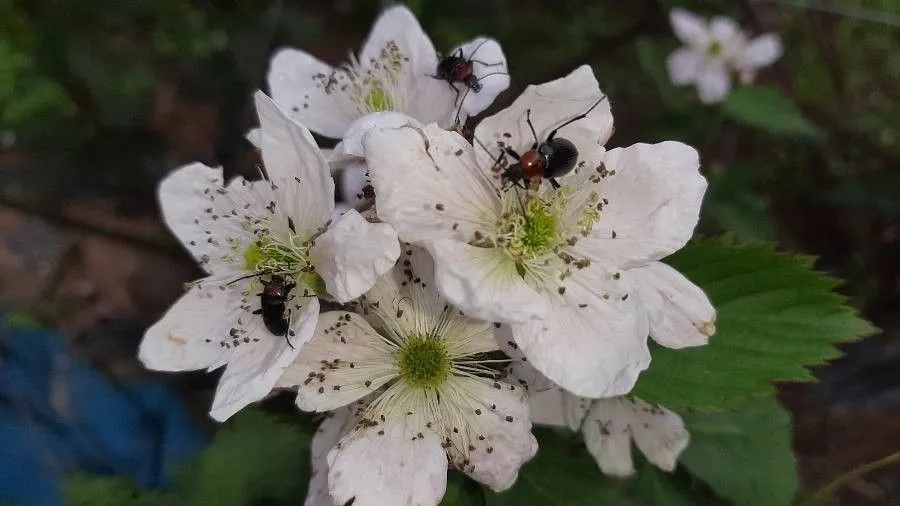
Author: Arrh.
Bibliography: Ruborum Suec.: 15 (1839)
Year: 1839
Status: accepted
Rank: species
Genus: Rubus
Vegetable: False
Observations: Europe
The Pruinose Bramble, scientifically recognized as Rubus pruinosus, is an intriguing member of the Rosaceae family. This particular species has piqued the interest of botanists and plant enthusiasts alike due to its distinctive characteristics and its geographical distribution primarily across Europe.
First documented by Arrh. in 1839 within the publication “Ruborum Suec.: 15,” the Pruinose Bramble has since been subject to extensive study. The term “pruinose” refers to the plant’s unique, frost-like coating, which gives its foliage and stems an ethereal, frosted appearance, enhancing its visual appeal and distinguishing it from other members of the Rubus genus.
As a member of the Rosaceae family, the Pruinose Bramble shares many commonalities with its relatives, including its propensity for producing berry-like fruits, which, although variable in size and flavor, contribute significantly to the biodiversity and ecological dynamics of their habitats. The bramble’s fruits are not merely ornamental; they serve as a vital food source for a variety of wildlife, thus playing a crucial role in supporting local ecosystems across Europe.
The Pruinose Bramble thrives in a variety of settings, often favoring the temperate climates found throughout its native range in Europe. It can often be found in woodlands, hedgerows, and other semi-wild areas where it forms dense thickets. These growth patterns not only support the plant’s survival and proliferation but also provide shelter and foraging opportunities for numerous bird species and small mammals.
Despite its robust and somewhat aggressive growth habit, the Pruinose Bramble holds significant botanical and ecological value. Its capacity to rapidly colonize and stabilize disturbed soils makes it an asset in erosion control and land rehabilitation projects. Moreover, ongoing observations and studies of Rubus pruinosus contribute valuable insights into the adaptive strategies and evolutionary processes of bramble species within the Rosaceae family.
In conclusion, Rubus pruinosus, the Pruinose Bramble, stands out as a remarkable plant with a rich history and substantial ecological importance. Its unique characteristics, adaptability, and the role it plays in its natural habitat underscore the significance of continued research and conservation efforts dedicated to this and other similar species within the diverse and widespread Rubus genus.
Deu: bereifte haselblatt-brombeere, bereifte haselblattbrombeere
Dan: bølgebladet hasselbrombær
Eng: pruinose bramble
Nob: doggbjørnebær
Nno: doggbjørnebær
Swe: hallonbjörnbär, lehtovatukka
Fin: lehtovatukka
Nld: ronde purperbraam
En: Pruinose Bramble
Da: Bølgebladet hasselbrombær
Nl: Ronde purperbraam
Fi: Lehtovatukka
Fr: Ronce à feuilles de noisetier
De: Bereifte Haselblatt-Brombeere, Bereifte Haselblattbrombeere, Haselblattbrombeere
Nb: Doggbjørnebær
Nn: Doggbjørnebær
Sv: Hallonbjörnbär, Lehtovatukka
Taken May 29, 2022 by Sonia (cc-by-sa)
Taken May 30, 2011 by Tela Botanica − Pascal DUBOC (cc-by-sa)
Taken May 30, 2011 by Tela Botanica − Pascal DUBOC (cc-by-sa)
Taken May 30, 2011 by Tela Botanica − Pascal DUBOC (cc-by-sa)
Taken Apr 27, 2021 by ANTONIO Rodriguez (cc-by-sa)
Taken Oct 30, 2022 by Uta Groger (cc-by-sa)
Taken May 17, 2019 by Dietze (cc-by-sa)
Taken May 30, 2022 by Line Bauer Gylling (cc-by-sa)
Taken Jul 11, 2022 by Maaike La gare au Calme (cc-by-sa)
Taken Jul 11, 2022 by Maaike La gare au Calme (cc-by-sa)
Taken May 30, 2011 by Tela Botanica − Pascal DUBOC (cc-by-sa)
Taken Apr 26, 2021 by vivi di benedetto (cc-by-sa)
Taken Jul 11, 2022 by Maaike La gare au Calme (cc-by-sa)
Taken Aug 25, 2021 by Dario Rothauer (cc-by-sa)
Taken May 11, 2022 by Jerry Boozer (cc-by-sa)
Taken Apr 26, 2022 by Luca (cc-by-sa)
Taken Aug 20, 2022 by Eliott Guillaume (cc-by-sa)
Taken Jun 5, 2022 by Dirk Warmsbach (cc-by-sa)
Taken May 26, 2021 by Guillaume Dumon (cc-by-sa)
Taken Jun 11, 2021 by Mathieu VALENTIN (cc-by-sa)
Taken May 30, 2011 by Tela Botanica − Pascal DUBOC (cc-by-sa)
Taken May 30, 2011 by Tela Botanica − Pascal DUBOC (cc-by-sa)
Taken May 30, 2011 by Tela Botanica − Pascal DUBOC (cc-by-sa)
Taken Jun 21, 2022 by cj swash (cc-by-sa)
Taken May 30, 2011 by Tela Botanica − Pascal DUBOC (cc-by-sa)
Taken May 27, 2022 by Pricia (cc-by-sa)
Taken Jun 5, 2022 by Dirk Warmsbach (cc-by-sa)
Taken Aug 15, 2009 by Photoflora – Jean-Luc TASSET (©)
Taken Aug 15, 2009 by Photoflora – Jean-Luc TASSET (©)
Taken Aug 15, 2004 by Photoflora – Jean-Luc TASSET (©)
© copyright of the Board of Trustees of the Royal Botanic Gardens, Kew.
© copyright of the Board of Trustees of the Royal Botanic Gardens, Kew.
© copyright of the Board of Trustees of the Royal Botanic Gardens, Kew.
Family: Myrtaceae Author: (F.Muell.) K.D.Hill & L.A.S.Johnson Bibliography: Telopea 6: 402 (1995) Year: 1995 Status:…
Family: Rubiaceae Author: Pierre ex A.Froehner Bibliography: Notizbl. Bot. Gart. Berlin-Dahlem 1: 237 (1897) Year:…
Family: Sapindaceae Author: Koidz. Bibliography: J. Coll. Sci. Imp. Univ. Tokyo 32(1): 38 (1911) Year:…
Family: Asteraceae Author: A.Gray Bibliography: Pacif. Railr. Rep.: 107 (1857) Year: 1857 Status: accepted Rank:…
Family: Fabaceae Author: Medik. Bibliography: Vorles. Churpfälz. Phys.-Ökon. Ges. 2: 398 (1787) Year: 1787 Status:…
Family: Aspleniaceae Author: (Cav.) Alston Bibliography: Bull. Misc. Inform. Kew 1932: 309 (1932) Year: 1932…